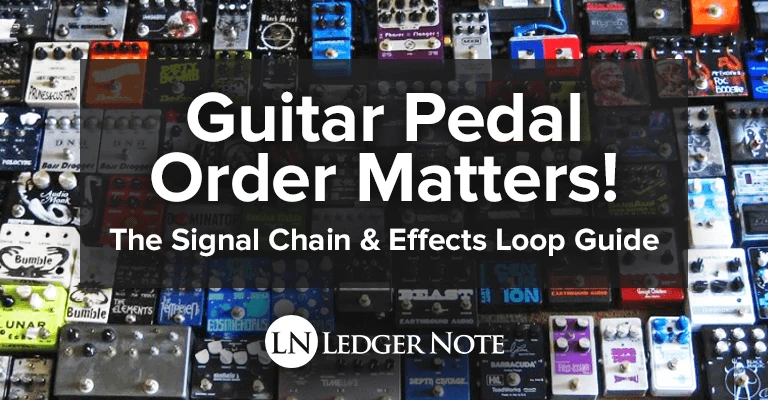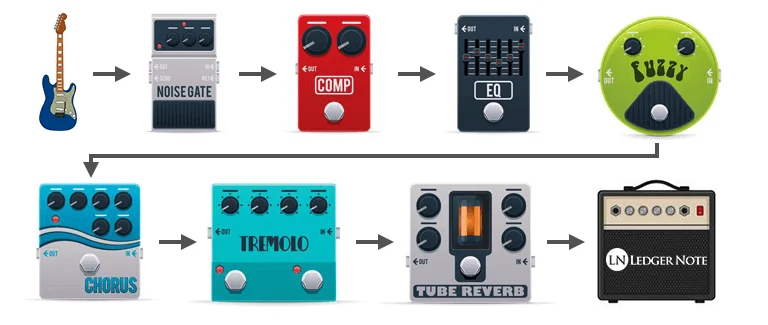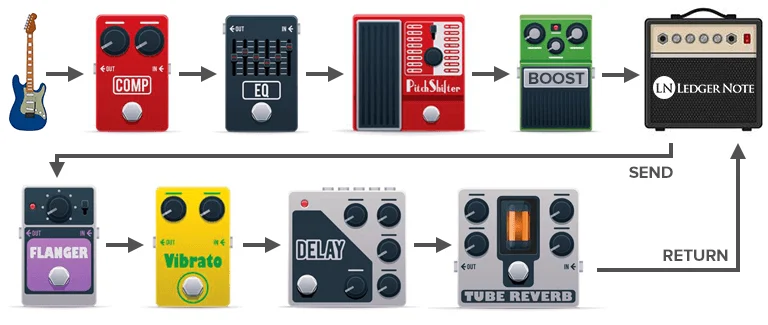
This nightmare question gets asked once per musician, they spend a couple days tormenting themselves over it, then it finally all clicks into place. That question?
“What’s the best order for my guitar pedals?”
The problem arises from realizing you may be using as many as six or even 12 pedals, and even more on a pedalboard. The number of various ways you can mix up the signal path climb into the hundreds.
It does sound intimidating when you read platitudes like “There is no official rule on how to do it, and you should break the rules and experiment because that’s what art is, and you’ll invent something new.”
Some people even tell you to figure it out yourself, which is equally absurd. It developed over decades. No one person is going to just sort it out by themselves over night.
And no. This isn’t purely art. It’s at least halfway science and engineering if not even more. Fortunately for us most of the choices get reduced down so that the complexity of the situation goes from mind-numbing down to very manageable and sensible.
Here’s how we’re going to deal with this. First I’ll explain to you the five main classifications of effects types and lay out the proper order in respect to those groupings. Then I’ll explain why it works this way and you’ll realize why this is correct.
Yes, you can mix it up however you want and get disastrous results, or you can let reason guide you so you can get professional results. My goal here is to make this make as much sense as possible in the shortest amount of time possible.
Let’s start with some ground rules of logic that will set the stage for the order.
The 4 Rules for the Guitar Effects Order
These are four broad rules that quickly narrow down the possibilities of the guitar signal chain. And no, “there are no rules” isn’t one of them. There is a logical guitar pedal order everyone follows.
Rule 1 – There is a logical order for groups of effects. Some effects remove or add certain amount of frequencies, some change the basic shape of the audio waveform, and others react to the shape and amplitude of the waveform.
Those are three main types of effects that logically can’t come in any other order than they were just listed, or you end up with amateur results. The reason for that becomes clear in the next rules.
Rule 2 – This order is defined by nature and physics. Consider this scenario. You scream and your lungs, mouth shape, and vocal chords define the frequencies that come out. You cup your hands around your mouth to shape the waveform and affect the stereo width.
Then your voice goes out into the air and into the Grand Canyon where it bounces around and comes back at you with reverb and delay. If you don’t at least follow this fundamental order, you’ll be too far out of touch with your listeners and you won’t be able to sound acceptable within the mix of a song.
Rule 3 – Experimentation occurs within these groups of effects. While these three major groupings need to follow a strict order, the effects within those groups can be toyed with to invent new sounds.
For instance, you can apply a reverb to your echo delay or apply an echo to your reverb. But that general group of time-based effects needs to come at the end of your effects chain, regardless.
Rule 4 – The technology further defines the order. Let’s give a couple examples here. If you don’t use your noise gate before your compressor, you’ll increase the volume of your noise which renders your noise gate useless.
If you send an impure signal like heavy distortion to a harmonizer, the harmonizer will be very inaccurate, thus you want to apply distortion to the harmonized signal and not the other way around. If you compress before using equalization, the compressor may act on frequencies you don’t intend to keep in the signal, thus you should EQ first.
These four rules lay out the ground logic for why there is a specific ordering for your effects pedals, despite what others may tell you with their lofty ideals and non-pragmatic advice.
The Correct Guitar Pedal Order
With the four base rules established, let me show you the actual five groups of effects in the order you’ll want to use them, then we’ll explain what each includes and why they’re grouped the way they are:
- Dynamics
- Filters & Shifters
- Gain
- Modulation
- Time
You will never want to stray from the above order. It is defined by the four ordering rules and will make more sense once you understand what belongs in each grouping. Let’s look at that then I’ll give you an example signal path using as many effects as possible in the effects chain.
Dynamics
The dynamics group contains effects that change the shape of the waveform in terms of variances in volumes. That is what the term dynamics refers to, which is the rising and falling of amplitudes and the amount of decibels by which they change.
This group contains two effects pedals, which are the noise gate and compressor (and most of the time a volume pedal). You don’t want to change that ordering, because of the result of compression. It reduces the variance between the highest peaks of volume and the lowest.
And if you haven’t taken the noise out of your signal yet using the noise gate, your signal-to-noise ratio becomes lower, making it more difficult to take out the noise in a musical fashion (it’ll have more abrupt and noticeable moments of silence).
It should be mentioned explicitly that your tuner pedal should go at the very beginning of your signal path in front of all others, and disengaged into true bypass mode when not in use.
Filters & Shifters
The filters and shifters group also shapes the waveform but in a different fashion than the dynamics group. First and foremost, now that you’ve gotten rid of noise and extreme volume variances, you want to use an equalizer to tweak your tone.
You may roll off extra bass frequencies and increase some high frequencies while dipping the mids. You want this done before you apply the more obvious effects in the next groupings.
Also, after EQ, you’ll use other types of filters or shifters. You may use an envelope filter (also called an auto-wah) or a wah wah pedal to continue to shape the dynamics slightly and affect the frequency response. You want to do this after you’ve set your general tone with EQ though.
Included here after the filters are shifters like your standard pitch shifters, harmonizers, or octave pedals. You want to take care of any pitch changing (I’d argue even vibrato should happen here) before you add other effects into your signal, since they will react to the audio signal itself.
You don’t want to add reverb and then try to pitch shift, because the signal you send becomes too complex and inaccurate for such a precise effect.

Side Note: The above is a visual example of how the wrong pedal order screws up your tone. When you compress before using delay, you get a perfectly shaped note ringing out and decaying uniformly over time.
If you delay before compressing and even normalize with your make-up gain, you still lose volume and power due to the attack sneaking through first. Then your delayed notes are all also compressed, ruining your fine-tuned echo decay so that all echoes are relatively too loud and don’t decay equally over time.
Gain
The gain group contains effects that are associated with or require high gain. Here you might use a boost pedal to increase the volume before you feed it into distortion pedals, which are also included here. So whether that’s a distortion, overdrive, or fuzz pedal, they all belong here.
You want this before all of the remaining effects because you want, for example, a distorted signal to be delayed, not a delayed signal to be distorted. You can try it the reverse way but you’ll end up with varying results since the gain will change during reverb tails, decaying delay echoes, and crazy chorus or flanger effects.
And since these effects in this group rely on gain, you want to feed them a consistent and high gain signal, which gets reduced by other effects.
Modulation
The modulation group refers to effects that are cyclically changing the volume signature of your signal or its place in the stereo field by whipping the panning back and forth.
These include choruses, flangers, and phasers (and I’d put tremolo here as well). Because each of these requires duplicating your signal once or several times, you want to do it after you’ve added all of the other dynamic, filter-based, and gain effects.
There is no sense in trying to get a distortion or equalizer pedal to react to a series of recombined signals when you can take care of that before hand. You’ll get much higher quality and accurate modulation out of it this way.
Time
Finally, we come to our time-based (and space-based) effects group. This includes reverb and delay. Both are forms of the same effect with reverb being a much faster version of delay.
All they do is take the input and “smear it out” while reducing the volume over time. Not only does this create an extremely complicated signal that other effects won’t react to well, but the variances in volumes these create would further confuse the previous pedals.
If you want another way to think about this, we’ve previously discussed the types of guitar pedals in a way that organized them differently. It’s nearly the same with more sub-categories, essentially. But if you’re still confused, this look from another angle might help.
Two Example Guitar Effects Pedal Orders
As you can see above, our four logical rules nearly demand that our five pedal groups come in the order they come in, and even within the groups there isn’t much room for changing things around, except for the modulation group.
Let’s now look at two real-life examples of what this would look like with a realistic setup. Our first example will be a linear sequence without an effects loop, while the second will use an amplifier effects loop.
It should be noted that many pedals themselves can host their own effects loop, so how you set it up is up to you. It functions the same either way as long as your can mentally keep track of the linear guitar pedal order.
First Guitar Pedal Order Example
Here is an example of a linear signal path from guitar, through pedals, to the amplifier.
Guitar > Noise Gate > Compressor > Equalizer > Fuzz > Chorus > Tremolo > Reverb > Amplifier
Keep in mind our four fundamental rules and the five types of effects and you’ll see that they hold true in example. Here is the same example in image form:

This is the most straight forward and easy to conceive of method of connecting your guitar pedals in order, because they come one after another with no additional complications of an effects loop. Let’s discuss what that is and then take a look at a second example that includes it.
What is an Effects Loop?
A pedal itself can have an effects loop, but the most commonly used place is on the amplifier itself. You’ll see on most amps (but not all) some form of output labeled as Effects Send or Preamp Out accompanied by an input labeled Effects Return or Power Amp In, respectively.
Both sets of outputs and inputs refer to the effects loop that you can add between the preamplifier and the power amp section of your amplifier.
The main reason this exists is because some players prefer to drive their amplifier’s preamp with high gain to achieve distortion instead of using an emulation through a pedal. This means that you can’t push modulation and time-based effects into the preamp since distortion will come after them.
Again, you can do this but it will sound horrible because it breaks our four main rules above. Nobody wants a muddy, smeared, and washed out tone, and thus the effects loop exists.
We should mention that there are series effects loops and parallel ones as well. The difference is that parallel splits your signal while series treats it like an extension of the linear signal path.
Understanding why this is an option doesn’t matter right now and doesn’t affect our examples, but don’t be surprised if you see it on your amp.
Second Guitar Pedal Order Example
Our second example includes a effects loop in series at the amplifier. This doesn’t really change your guitar pedal order since it’s still a linear pathway.
Guitar > Compressor > Equalizer > Pitch Shifter > Boost > Amplifier (Send) > Flanger > Vibrato > Delay > Reverb > Amplifier (Return)
The send and return indicate the start and stop of the effects loop. Here it is visually, which should make things much more clear:

Again, the entire purpose of the effects loop is to allow you to use your amplifier’s preamp to get natural distortion and then apply modulation and time-based effects, rather than having distortion applied to them, which sounds bad.
Your Guitar Pedal Order Matters!
And that’s a wrap. If you’re new to the pedal game, don’t let anyone tell you that there are no rules. There are some very strict rules that apply if you want to sound professional, and these rules quickly reduce the amount of options down to very few, indeed.
The honest and realistic among us will tell you the truth that there is a very firm effects pedal order you should connect your pedals in that you don’t want to stray from unless you want to ruin your tone and appear to not know what you’re doing. Guitar pedal order matters!